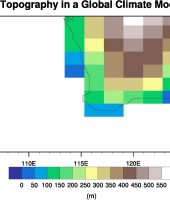Safeguarding sea habitats from extra salinity
Western Australia is increasingly relying on desalination plants to supply our drinking water. A by-product of desalination, concentrated brine, is currently disposed of by dilution with seawater offshore. Dr Jason Antenucci and Dr Alireza Valizadeh from DHI Water and Environment are working with Water Corporation to ensure that conditions for brine disposal offshore can meet environmental safeguards whether the ocean is as still as a bathtub or monster waves are pounding the coastline.
Brine outfalls from seawater desalination plants are currently designed to mix and dilute the brine discharge to an environmentally acceptable level with little consideration of how wave action may increase or restrict the rate of dilution. Existing modelling of brine outfalls assumes the surrounding water is still, with the brine plume steadily diffusing and diluting as it pushes out from a seafloor outlet, up in an arc towards the water surface before sinking back down again.
Dr Antenucci explains: “The brine plume diffuses along an arc through the water column, a bit like how water from a water cannon arcs up through the air and comes down to land again at a distance. It’s easy to see how it disperses when the air is still, but predicting how it will spread and fall in gusty winds is more difficult.”
Mr Grant Griffith, an environmental engineer at Water Corporation, points out that a drying climate and increased demand for water is likely to result in an increased reliance on climate-independent water sources including seawater desalination. “Most of our coastline is affected by big swells and waves, and we need to ensure we achieve the best possible environmental outcomes if we introduce a brine outfall into the ocean from a desalination plant.”
With no information available worldwide on the effects of waves on brine outfalls, Water Corporation is working with DHI to model how brine plumes diffuse in more energetic environments.
The Solution
Dr Antenucci and Dr Valizadeh are using computational fluid dynamics modelling to explore how brine is diluted under different conditions. “Because brine is denser than water, you want to maximise the length of the path the plume can diffuse over – you push it out at the ocean floor, angled up so it almost reaches the water surface, and then it gradually drops back down, effectively doubling that initial path length,” describes Dr Antenucci.
“The problem covers several orders of magnitude,” Dr Antenucci explains. “The diffuser outlets are about 150 mm diameter, so we need to be able to resolve brine mixing with seawater at the outlet at the centimetre scale. They’re normally placed on the ocean floor at a depth of 10–20 m, and the plume may discharge over a path length of 20–70 m, affected by waves having a wavelength of up to 300 m. It is these differences in scale that require resources at Pawsey.”
Dr Antenucci notes that: “It may not be a massive computational problem by Pawsey standards, but even if we can use a thousand cores, it takes a couple of days to run each simulation”. Mr Griffith agrees, observing that: “We just can’t model these scenarios without supercomputing – it’s probably why no-one has previously studied the effect of swell on brine outfalls until now! Previous calculations have all been done in steady-state ‘bathtub’ conditions, or with a steady current.”
Outcome
The first phase of the modelling project has confirmed that brine dilution can be reduced up to 60 per cent under some specific wave conditions. “We’re seeing in some conditions that the waves smudge out that plume arc – they don’t allow the plume to reach the water surface, which decreases the effective path length for diffusion,” says Dr Antenucci.
Phase two of the project is now exploring which wavelengths, periods and amplitudes of waves cause the most problems, and testing various diffuser design variations and orientations with respect to the wave direction.
The aim is to arrive at new design guidelines that can be applied globally to account for the impacts of waves on brine outfalls. “We will be able to ensure effective brine dilution that meets our environmental requirements under a wide range of wave conditions,” says Mr Griffith. “This will directly inform the design decisions being made for Western Australia’s next desalination plant, which is likely to be constructed in a high-energy, open ocean environment.”
“We’re keen to improve the global best design practice for these brine outfalls. There are going to be more desalination plants built in Australia in the future, and these design guidelines will also be relevant to denser-than-water industrial discharges to the open ocean globally.”
Project Leader.

Brine outfall modelling image courtesy Dr Jason Antenucci, DHI





